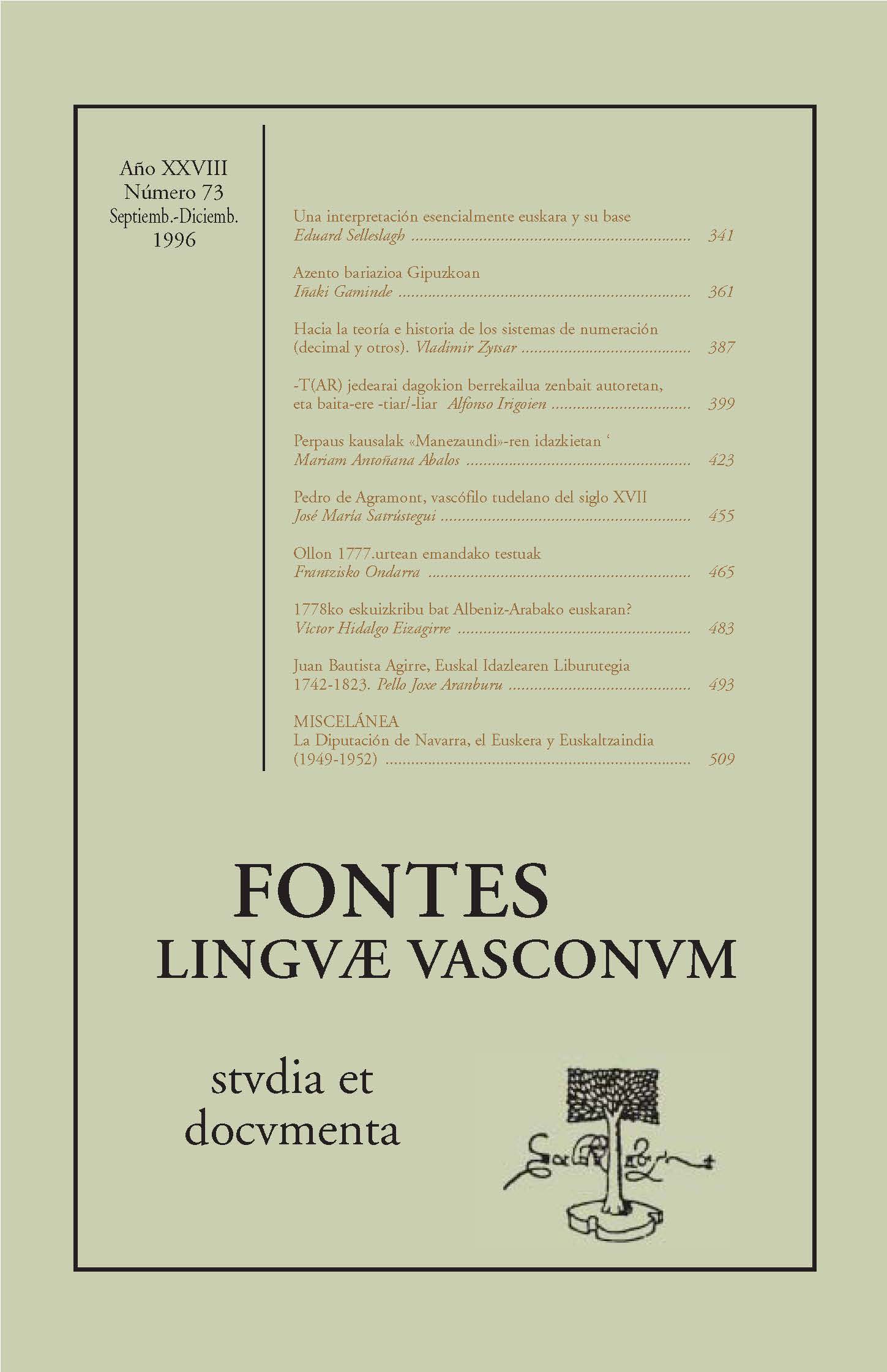La estela ibérica de Sinarcas: Una interpretación esencialmente éuskara y su base
Abstract
Even though the main purpose of the article is an interpretation of the iberian text inscribed on the stele from Sinarcas (Valencia, Spain) by means of lexemata from euskara and grammatical affixes from nostratic languages, it dedicates a large amount of space to the defense of its methodological base.
A first part treats the problem from a purely linguistic point of view, limited to the Spanish territory, and comes to the conclusion that euskara must preserve a large number of lexemata found in iberian, whatever the relation between both languages. It also explains why iberian remained so impenetrable, notwithstanding the preceding.
In a second part the possible relationship between basque and iberian is examined from an anthropological point of view. This study has found a multitude of cultural (archeological and linguistc) and genetic traces of iberian or euskaroid migrations from the Caucasus to the mediterranean space, and further on to northwestern Europe. It also detected endings and affixes that are common to very distinct branches of the nostratic family and to euskara, a fact that makes the use of such elements for completing the arsenal of tools for deciphering iberian all the more acceptable.
Finally, the article proposes an interpretation of the iberian text compatible with its function on a funeral stele.
##about.statistics##
References
Michelena, Luis (1976): Ibérico -en, en "Actas del I Coloquio sobre lenguas y culturas prerromanas de la Península Ibérica", 1979, 353-361.
Renfrew, Colin (1992): World Languages and Human Dispersals: A Minimalist View, en "Transition to modernity: Essays on Power, Wealth and Belief", bajo la dirección de J. A. Hall y I. C. Jarvie, 1992. https://doi.org/10.1017/CBO9780511628092.002
Renfrew, Colin (1989): Archaeology and Language, The World of Penguin, 1989.
Renfrew, Colin (1991): The Cycladic Spirit, Goulandris, 1991.
Cavalli-Sforza, Luigi Luca and Piazza, Alberto et al. (1988): Reconstruction of human evolution: Bringing together genetic, archeological and linguistic data, en "Proceedings of the National Academy of Science, USA", 1988, 85, 6002-6006. https://doi.org/10.1073/pnas.85.16.6002
Ruffié, Jacques (1951): Les groupes sanguins en anthropologie, en "Annales de l'Institut des Études Occitanes", 1951, 8, 41.
Bernard, Jean y RUFFIÉ, JACQUES (1971): Hématologie et culture, le peuplement de l'Europe de l'ouest, en "Anthropologie de la France", 1971, 661-675.
Bernard, Jean (1981): Le sang des hommes, 200-202, Paris, 1981.
De Beer, Sir Gavin (1965): Genetics and Prehistory, Columbia University Press, 1965.
Arnold, Paul (1984): Le mystère basque dévoilé. Edición española (mejorada y complementada) de 1986: El misterio vasco desvelado, Ediciones Mensajero, Bilbao, 1986.
Echenique-Elizondo, Mª. Teresa (1987): Historia lingüística vasco-romanica, Paraninfo, Madrid, 1987.
Michelena, Luis (1968): L'euskaro-caucasien, en "Le langage", vol. XXV de l' "Encyclopédie de la Pléiade", 1968, 1414-1437.
Bengtson, JOHN D. (1996): Correspondences of Basque and Caucasic vowels : -i/-e, -u/-o, en FLV, 71, 1996.
Morvan, Michel (1996): A propos de comparaisons de noms d'insectes en kartvèle et en basque, en FLV, 71, 1996.
Satrústegui, José Mª (1987): Mitos y Creencias, 4.ª edición, Iruñea, 1987.
Ortíz-Osés, Andrés (1985): Antropología simbólica vasca, Anthropos, Editorial del Hombre, Barcelona, 1985.
Schwerteck, Hans (1995): Le mot basque gizon "homme", en FLV, 70, 1995.
Dumézil, Georges (1987): La religion archaïque romaine, Bibliothèque historique, Payot, Paris, 1987.
Meillet, A., Cohen, Marcel (1952): Les langues du monde, CNRS, Paris, 1952.
Patxi Íñigo, Patxi Salaberri y JUAN JOSÉ ZUBIRI (1995): -Ki aditz-atzizkiaren gainean, en FLV, 69, 1995.
Copyright (c) 1996 Eduard Selleslagh

This work is licensed under a Creative Commons Attribution-NonCommercial 4.0 International License.







